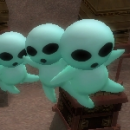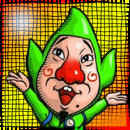*Technically they are slightly different because in TP they are always seen on their hands, and when they use their power the entire crest glows like a single triangle. Of course, such slight visual differences don't prove anything.
....and those are different from the Triforce-Ownership Crests...how?
Fine. What do you mean that the Triforce and Ganon are not the main focus on the plot, given that they are referenced in several places throughout the course of the game and Ganon is central to the game's ending? You can't just ignore something like Link's wolf transformation and the final boss battle.
We're not IGNORING it, for god's sake! We're just saying that matters such as Ganon and the Triforce are second priority to the Twili and the Shadow/Light dualism! It's called "theme".
Well, perhaps if theorists weren't so willing to jump into speculation with every new game, then timeline theorising wouldn't be such a mess. But instead, we have to debate the unflooding of Hyrule because ALTTP must follow TWW, and we have to debate Ganon magically travelling from the Four Sword to the Sacred Realm because FSA must lead into ALTTP. Perhaps if theorists looked at the evidence before the placement, we wouldn't have to debate stuff like this.
I agree. The fans can debate some pretty stupid shit.
As I said in my previous post, I can live quite happily with the trio possessing the Triforce in TP, because I agree that the similarities are visible enough to support the justification. My problem is with everything else that's being debated, like the back stories. I just don't understand why characters can't say exactly what they mean; theorists must always attach an arbitrary event that was said to occur in a previous game, and they then justify the absence of evidence with some ridiculous excuse like "It simplifies things".
And btw, Vaati is in TP, but he's not shown or mentioned in order to simplify the story (the developers didn't want Vaati to be the main focus of the game).
I agree that characters should say exactly what they mean, but they don't. Blame Nintendo for wanting to give the characters flowery dialogue.
If the Triforce was a well-recognised part of popular culture that everyone with a basic interest in film knew about (and parodied by the likes of Family Guy), I could agree with your comparison to Cloverfield. But it isn't; the large majority of people, especially newcomers to the series, might recognise the shape of the Triforce and connect that symbol with The Legend of Zelda, but they certainly aren't going to know how the Triforce works or understand the Triforce-splitting (especially in the context where no explanation for a split Triforce is provided). In order for the developers to assume that the player would understand these events, they would have to assume that the player had also played OoT, which becomes less and less reasonable as time goes by. The game is ten years old now; it's going to earn "retro" status soon if it hasn't already.
You're right; but the vast majority of fans will know all that. Didn't like...some developer, say....I don't know, something about unifying the plot and having faith in the players' senses?
And so for the people who haven't played OoT, they are left with plot holes, and this point in general contradicts a stated developer philosophy to make the individual storylines comprehensible for everyone. As the final boss, people are going to want to know where Ganondorf came from, and not explaining that properly is going to leave that part of Zelda's audience disappointed, which is not at all in the developers' best interests if they want to see more sales of future Zelda titles. Even Metal Gear Solid 4 is going to have in-game flashbacks to explain to new players what occurred in the previous three games, because the developers realise that not everyone who wants to play it will have owned a PS1 or PS2. I never played the NES Metal Gear games when I bought the Gamecube remake of MGS1, so thank god there was a section in the game that explained those stories to me.
"WAHH I DIDN'T UNDERSTAND THIS GAME BECAUSE I DIDN'T PLAY IT'S PREQUEL WAH WAH."
If they don't understand the story, but they enjoyed the gameplay, they'll probably go back and play the other games.
Fans aren't going to get upset if the Triforce is explained in yet another game, and that begs the question as to why Nintendo was apparently so ambiguous about it. Since it contradicts the basic principles of good storytelling, I firmly believe that these old conventions of the timeline have been dropped entirely. What the game says is what happens; simple as that.
Go ahead and try and enforce that rule. You're screwed.
I would agree normally, but given the current subject of discussion surrounding TP, I think the comparison is valid. Theorists look at the fact that TP is a sequel to OoT, but they ignore the fact that the game has no active narrative connections to OoT. It is an example of the timeline placement being used to determine the story, and that's in turn being used as a justification for rampant speculation. The fact is that Aonuma's Nintendo Dream interview still is the only definite piece of evidence connecting OoT to TP.
Just because there's no text saying that it's a sequel to OOT doesn't mean there isn't a shitload of other clues. There's more to understanding a story than reading the dialogue.
Zelda sent Link back with the Ocarina. That she was not supposed to do. WW tells us the Hero of Time was given the ToC to protect, but it departed from him when he "left through the flows of time". Why would the goddesses give him a piece to protect and then send him back in time to break it? Zelda OOT was the cause for all of this.
Sending him back in time was one thing, but that doesn't mean the timeline would split. What agency caused this to happen? Zelda didn't sing a "Time Split" song on the Ocarina.
That's very good to know! ..You could've told us a couple of years earlier
No one asks me, and before I get to a point where I can bring in something helpful, people have usually already reached the point of writing me off as not knowing what I'm talking about, like Impossible in that TMC debate. I admit I have a very short temper, so I usually try and leave debates before I get YELLING AND FUCKING CURSING AND SHIT AND CALLING YOU FUCKING NAMES and stuff.
I definitely understand why you would think so. I equated the scene of Rauru talking to Link when he first awakens with the Temple of Light itself, since Rauru tells Link its the last stronghold. Which I then concluded that since Link was trapped in the Temple of Time for seven years and then wakes up in the Chamber of Sages, which I equated with the Temple of Light, I figured the Chamber of Sages was in the Temple of Light which was in the Temple of Time. (Although this may not be true) So I was arguing with you that every time Link goes in that portal in each dungeon, it was a portal to the Chamber of Sages, which was in the Temple of Light, which was in the Temple of Time?
Actually, Link was sealed in the Sacred Realm. The Temple of Time is in Hyrule, but lifting the Master Sword creates a portal to the Temple of Light, which is in the Sacred Realm, where the Triforce is kept.


 This topic is locked
This topic is locked













